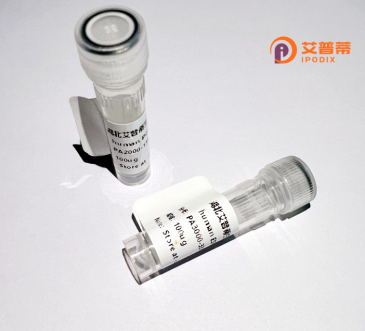
| 纯度 | >90%SDS-PAGE. |
| 种属 | Human |
| 靶点 | UFL1 |
| Uniprot No | O94874 |
| 内毒素 | < 0.01EU/μg |
| 表达宿主 | E.coli |
| 表达区间 | 2-794 aa |
| 活性数据 | ADAWEEIRR LAADFQRAQF AEATQRLSER NCIEIVNKLI AQKQLEVVHT LDGKEYITPA QISKEMRDEL HVRGGRVNIV DLQQVINVDL IHIENRIGDI IKSEKHVQLV LGQLIDENYL DRLAEEVNDK LQESGQVTIS ELCKTYDLPG NFLTQALTQR LGRIISGHID LDNRGVIFTE AFVARHKARI RGLFSAITRP TAVNSLISKY GFQEQLLYSV LEELVNSGRL RGTVVGGRQD KAVFVPDIYS RTQSTWVDSF FRQNGYLEFD ALSRLGIPDA VSYIKKRYKT TQLLFLKAAC VGQGLVDQVE ASVEEAISSG TWVDIAPLLP TSLSVEDAAI LLQQVMRAFS KQASTVVFSD TVVVSEKFIN DCTELFRELM HQKAEKEMKN NPVHLITEED LKQISTLESV STSKKDKKDE RRRKATEGSG SMRGGGGGNA REYKIKKVKK KGRKDDDSDD ESQSSHTGKK KPEISFMFQD EIEDFLRKHI QDAPEEFISE LAEYLIKPLN KTYLEVVRSV FMSSTTSASG TGRKRTIKDL QEEVSNLYNN IRLFEKGMKF FADDTQAALT KHLLKSVCTD ITNLIFNFLA SDLMMAVDDP AAITSEIRKK ILSKLSEETK VALTKLHNSL NEKSIEDFIS CLDSAAEACD IMVKRGDKKR ERQILFQHRQ ALAEQLKVTE DPALILHLTS VLLFQFSTHS MLHAPGRCVP QIIAFLNSKI PEDQHALLVK YQGLVVKQLV SQSKKTGQGD YPLNNELDKE QEDVASTTRK ELQELSSSIK DLVLKSRKSS VTEE |
| 分子量 | 89.5 kDa |
| 蛋白标签 | His tag N-Terminus |
| 缓冲液 | PBS, pH7.4, containing 0.01% SKL, 1mM DTT, 5% Trehalose and Proclin300. |
| 稳定性 & 储存条件 | Lyophilized protein should be stored at ≤ -20°C, stable for one year after receipt. Reconstituted protein solution can be stored at 2-8°C for 2-7 days. Aliquots of reconstituted samples are stable at ≤ -20°C for 3 months. |
| 复溶 | Always centrifuge tubes before opening.Do not mix by vortex or pipetting. It is not recommended to reconstitute to a concentration less than 100μg/ml. Dissolve the lyophilized protein in distilled water. Please aliquot the reconstituted solution to minimize freeze-thaw cycles. |
1. **"UFL1 mediates stabilization of HIPK2 through ubiquitin-proteasome system"** - Author: Li et al.
摘要:研究揭示UFL1作为E3泛素连接酶,通过调控HIPK2蛋白的泛素化修饰影响其稳定性,重组UFL1体外实验证实其直接结合并泛素化HIPK2.参与细胞凋亡信号通路。
2. **"Structural and functional analysis of UFL1 in the regulation of ribosome biogenesis"** - Author: Wang et al.
摘要:通过重组表达纯化人源UFL1蛋白,解析其与核糖体组装因子相互作用的结构基础,揭示UFL1在核糖体RNA加工中的关键作用及突变导致的细胞周期异常。
3. **"UFL1 modulates innate immune signaling by targeting STING for degradation"** - Author: Zhang et al.
摘要:研究发现UFL1通过泛素-蛋白酶体系统降解STING蛋白,抑制抗病毒免疫反应。重组UFL1实验证明其直接结合STING,为自身免疫疾病治疗提供新靶点。
4. **"Recombinant UFL1 facilitates DNA damage repair via modulating RPA1 ubiquitination"** - Author: Chen et al.
摘要:利用重组UFL1蛋白证明其作为E3连接酶调控RPA1的泛素化修饰,影响DNA损伤修复效率,并揭示其在肿瘤放疗敏感性中的潜在应用价值。
Ubiquitin ligase UFL1. also known as UBA5-associated ligase 1. is a key E3 ubiquitin ligase involved in the ubiquitin-proteasome system, which regulates protein degradation and cellular homeostasis. It plays a critical role in the ufmylation pathway, a post-translational modification similar to ubiquitination, by interacting with UBA5 (E1 enzyme) and UFC1 (E2 enzyme). UFL1 is primarily associated with endoplasmic reticulum (ER) stress response, cell apoptosis, autophagy, and DNA damage repair. Studies suggest its involvement in tumor suppression, neurodevelopment, and immune regulation.
Recombinant human UFL1 protein, generated via expression systems like E. coli or mammalian cells, is widely used to study its enzymatic activity, substrate recognition, and interaction networks. Structural analysis reveals conserved domains critical for E3 ligase function, including a canonical RING-finger motif. Dysregulation of UFL1 has been linked to cancers, cardiovascular diseases, and neurodegenerative disorders, making it a potential therapeutic target. Current research focuses on deciphering its substrate specificity, regulatory mechanisms in stress adaptation, and role in maintaining ER homeostasis. The development of recombinant UFL1 tools accelerates mechanistic studies and drug discovery aimed at modulating ufmylation-related pathways.
×